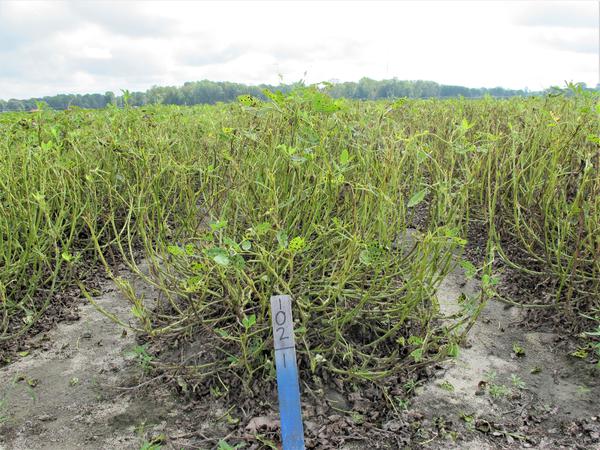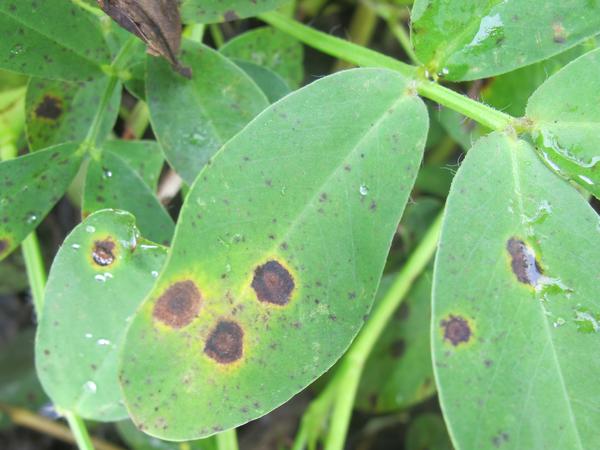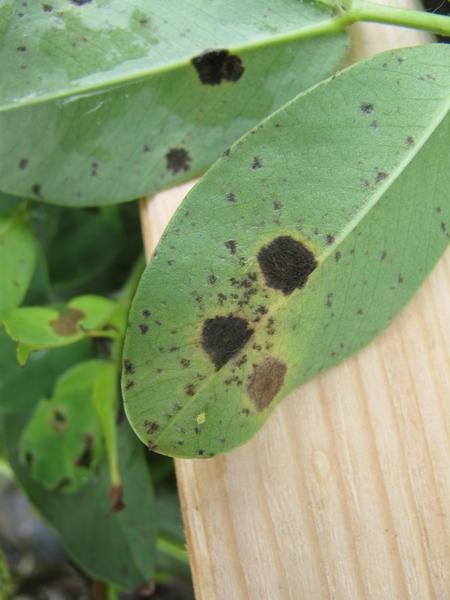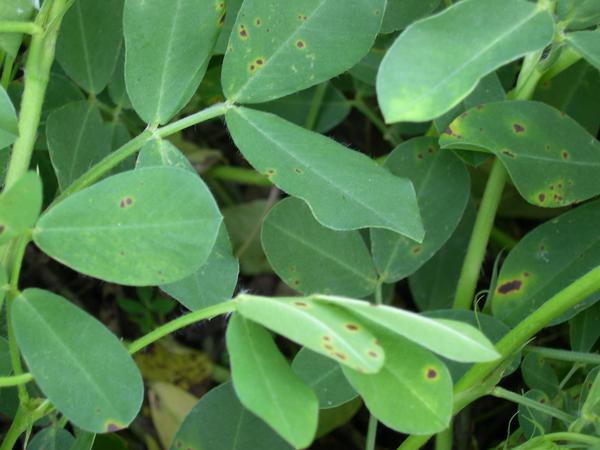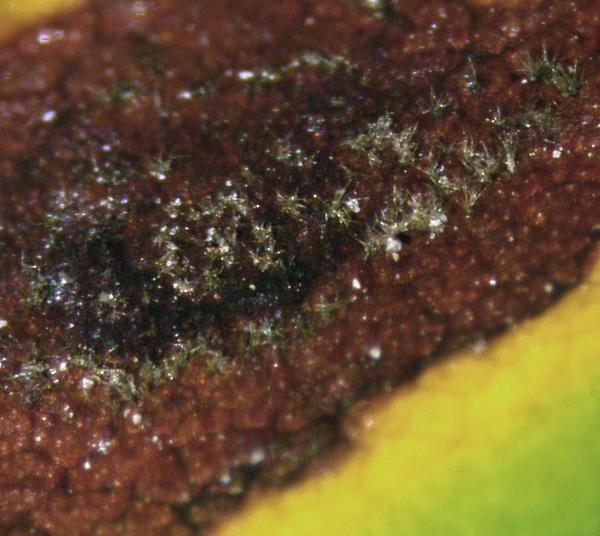General Information
Early leaf spot and late leaf spot are the most common and important peanut diseases in North Carolina. Leaf spot control is necessary to prevent defoliation and yield loss of 50% or more. Peanut leaf spots are caused by two different fungi: Nothopassalora personata (previously known as Cercosporidium personatum) causes late leaf spot and Passalora arachidicola (previously known as Cercospora arachidicola) causes early leaf spot. The predominant leaf spot disease can vary by location and shift over time depending on the cultivars grown, weather, and cultural practices. Late leaf spot currently is the predominant leaf spot disease in North Carolina.
Symptoms, Signs, and Diagnosis
Late leaf spot causes dark-brown to black leaf spots (lesions) that penetrate through the leaf and are visible on both the upper and lower leaf surface. The spots that may (or may not) be surrounded by a yellow halo. Young late leaf spot lesions appear as dark speckles while older lesions are rounded and dark brown to nearly black. Late leaf spot lesions produce masses of spores in humid weather. On the underside of the leaf, the dark mass of spores on the lower lesion surface gives the spot a velvety appearance that can be seen without magnification. As the name implies, symptoms of late leaf spot may not be evident until after the first of August. Once established, late leaf spot increases very rapidly. Aggressive disease control is needed to prevent yield loss
Early leaf spot typically causes penetrating brown lesions (spots) visible on the upper and lower leaf surface. A yellow halo usually is present around early leaf spots, but halos are NOT diagnostic since they also are common with late leaf spot. The difference between the brown lesions of early leaf spot and the dark-brown-to-black lesions of late leaf spot is most apparent on the lesions viewed on the underside of the leaf. Early leaf spot lesions are generally round, but can expand or grow together, becoming less regular in shape. The fungus produces tufts of silvery, hair-like spores on lesions during humid weather. These spores can be seen on the upper lesion surface with the help of a good magnifying glass or cellphone close-up. Although early leaf spot can be found as early as 30 days after planting, it usually is not observed in well-rotated fields until mid-July or later.
Early and late leaf spot symptoms are first seen on leaves at the bottom of the plant. Later, the number of spots increase as the disease progresses up the plant. Plants begin to defoliate, starting with the bottom leaves and moving into the upper canopy. In severe epidemics, plants are completely defoliated and die. The bare stems may also have lesions.
Early and late leaf spot can be difficult to differentiate from spots caused by pesticide injuries or irregular leaf spot, especially early in the season. Diagnosis is confirmed by the presence of spores on the upper (early leaf spot) or lower (late leaf spot) surface of the lesion. If spores are not present, sporulation can be encouraged by placing a few symptomatic leaves in a moist chamber (a plastic bag or container lined with a slightly damp paper towel). Incubate at room temperature for a day or two. Spores should be apparent when lesions are checked under low magnification.
Disease Cycle
Early and late leaf spot fungi overwinter in peanut crop debris. The old lesions on previously infected peanut leaves and stems produce spores that can infect the new peanut crop or peanut volunteers. These spores are dispersed in air currents, wind, or by splashing water onto peanut leaves. While most inoculum is local, spores can blow in from neighboring fields and occasionally over long distances, particularly during tropical storms.
The infection process begins when spores come in contact with susceptible peanut leaves. High humidity and temperatures between about 65 and 90 degrees F are very favorable for infection. Lesions become visible around 10 to 12 days after infection. Under favorable conditions, the lesions begin to sporulate 2 to 4 days later and continue to sporulate for up to two weeks. The spores dispersed onto peanut leaves begin a new cycle of infection. Infection and sporulation may be interrupted when humidity is low, but will resume when favorable conditions return.The infection and development process is somewhat faster with early leaf spot than with late leafspot, but the late leaf spot fungus sporulates prolifically and thus is more difficult to control. Defoliation begins as lesions accumulate on leaves. Defoliated leaves and infected leaves and stems from plants threshed at harvest are a source of inoculum for later peanut crops.
Factors That Favor Disease
Fields with short rotations and a history of severe leaf spot problems are at high risk for leaf spot. High populations of volunteer peanuts in peanut or rotation crops are also at risk for high levels of leaf spot.
Warm, humid weather favors infection, spore production and rapid disease increase. Favorable weather can occur anytime from late June to early October but is most common from mid-July to mid-September. Risk of leaf spots increases when humidity is higher than 90% for several hours. This usually happens overnight and on humid mornings. Prolonged rainy periods are very favorable for leaf spot, but weather can be favorable for disease during dry spells if humidity and dew points are high.
Disease is most likely to develop first in low-lying places or in shaded edges of fields. High humidity and leaf wetness periods tend to be prolonged in these areas. Irrigated fields are likewise at higher risk than fields under dryland production. Additionally, lush canopy growth results in increased moisture within the canopy and higher disease risk.
Late planting increases leaf spot risk since weather tends to become more favorable for leaf spots as the season progresses. Late planting also increases the risk that sprays or harvest will be delayed due to the greater likelihood of tropical storms in late summer.
Cultural Control
Peanut is the only known host for both leaf spot fungi. For this reason, rotations of 3 years or more with any crop other than peanut help to reduce severity of disease. The amount of inoculum carried over to the next peanut crop decreases with every year of rotation, whereas poor rotations increase the likelihood and severity of leaf spot epidemics. It is important to control peanut volunteers in rotation crops since leaf spot can infect and increase on volunteer peanut plants.
Peanut cultivars vary in susceptibility to both early and late leaf spot. Many Virginia-type cultivars (such as Bailey and Sullivan) and some runner-type cultivars have moderate resistance to early leaf spot. However, most currently available Virginia-type cultivars are susceptible or highly susceptible to late leaf spot, which has decreased the overall utility of leaf spot resistance.
Chemical Control
Fungicides must be applied in advance of infection so prevention is the key to effective leaf spot control. Regular fungicide applications are required to manage leaf spots in North Carolina. Yield losses of 50% or more can be expected if fungicides are not used or are used incorrectly.
In fields that have been rotated at least three years, the first fungicide spray (calendar spray or advisory) should be applied at the very early pod stage (R3), which usually occurs in the first week of July. Starting sprays before July 1 is not justified except in poor rotations. Most fungicides should be reapplied every 14 days or according to the leaf spot advisory. Sprays should continue until 14 to 21 days before harvest. A total of five to six sprays is sufficient for leaf spot control in most fields and years in North Carolina. Some fungicides provide leaf spot protection for 21 to 28 days. Check the product label for the correct rate and additional recommendations.
Because disease develops only in favorable weather, weather-based advisories can be used to delay or eliminate sprays during unfavorable periods. Contact your county Extension agent for more information on advisories in your area. Leaf spot advisories are intended for use on dry-land peanuts and should not be used on irrigated peanuts.
Leaf Spot Fungicide Resistance and Resistance Management
Repeated use of selective fungicides can select for fungicide resistance in early and late leaf spot fungi. Selective fungicides are placed in different fungicide resistance groups based on their mode of action. The most common fungicides used for leaf spot control in North Carolina belong to resistance groups 3, 7, and 11. To prevent fungicide resistance, mix or alternate fungicides from different resistance groups and use non-selective (group M) fungicides for two or more sprays per season. See product labels and North Carolina Peanut Information for additional resistance management guidelines.
More Information
North Carolina Agricultural Chemicals Manual
Peanut leaf spot advisory
NC State Extension Peanut portal
Publication date: May 14, 2020
N.C. Cooperative Extension prohibits discrimination and harassment regardless of age, color, disability, family and marital status, gender identity, national origin, political beliefs, race, religion, sex (including pregnancy), sexual orientation and veteran status.

